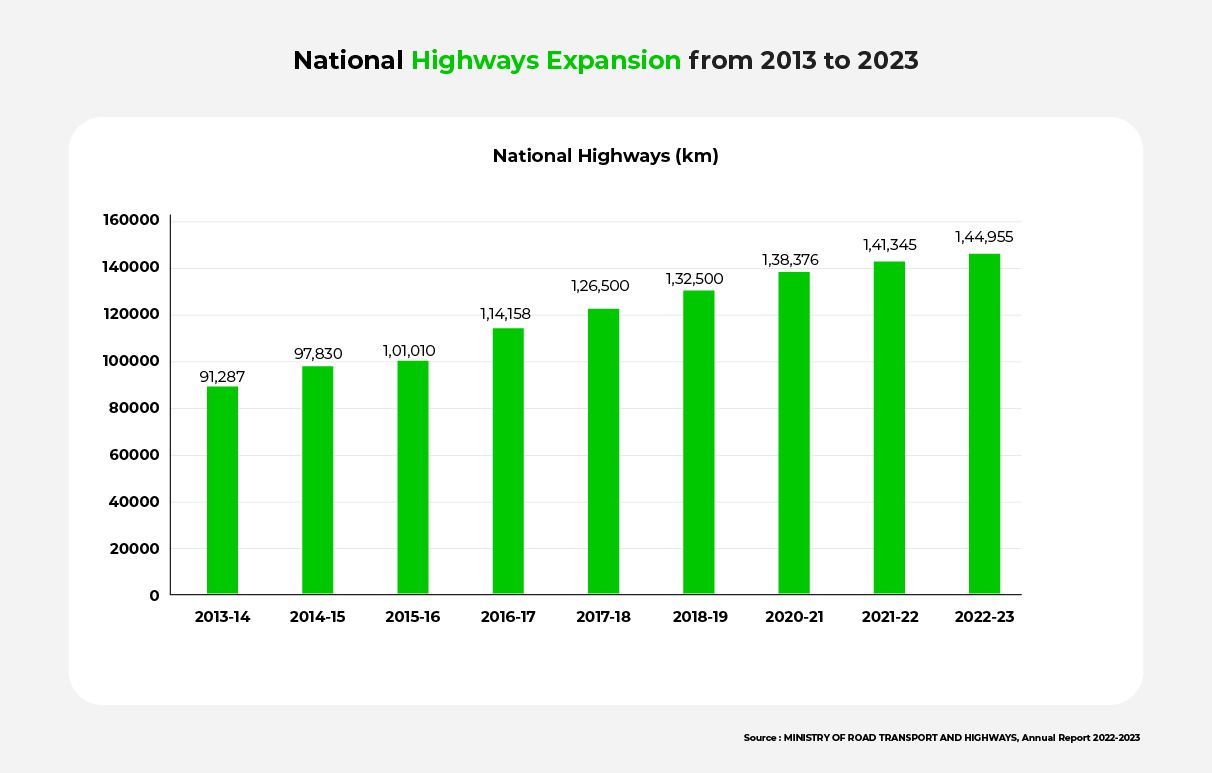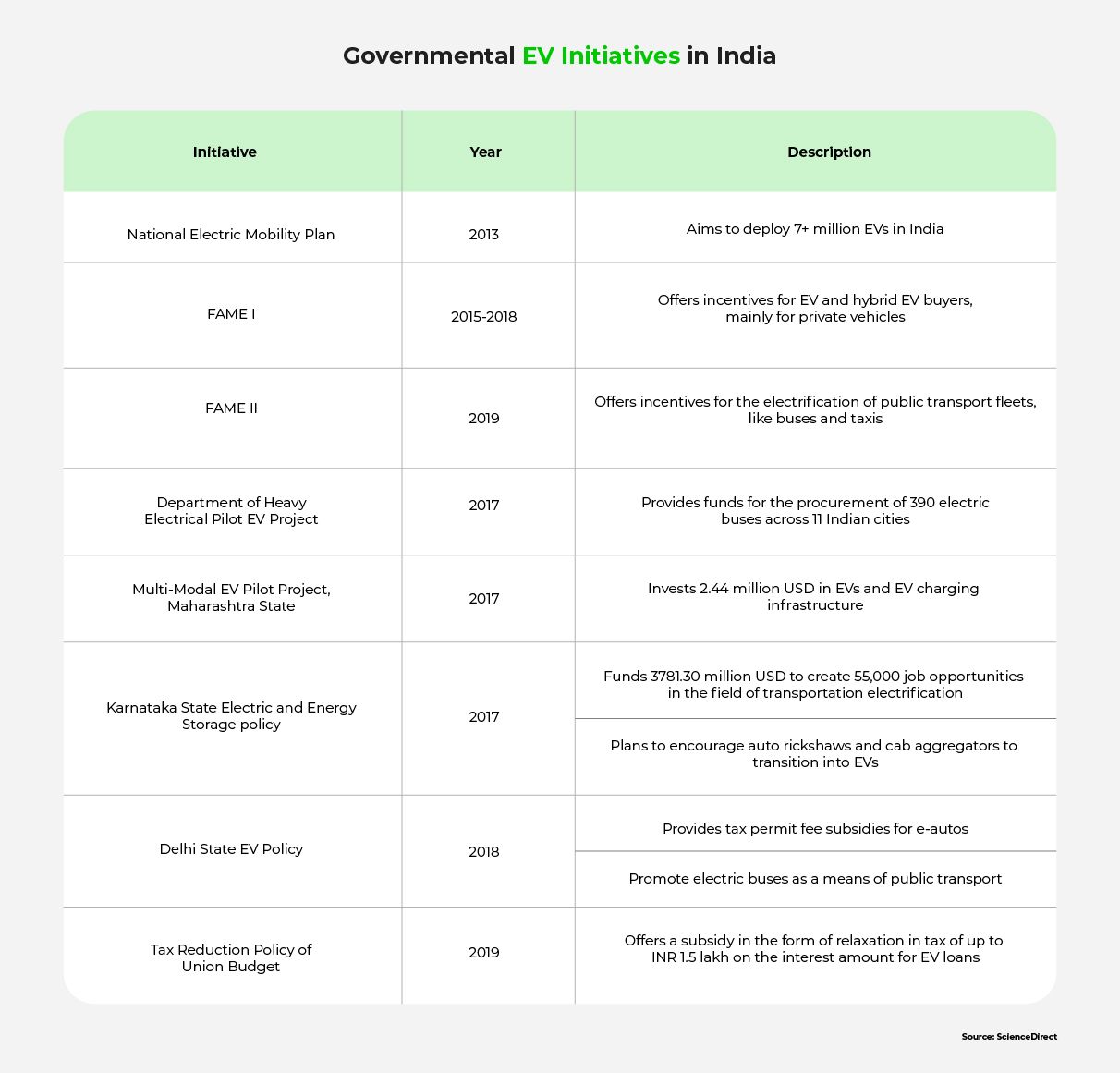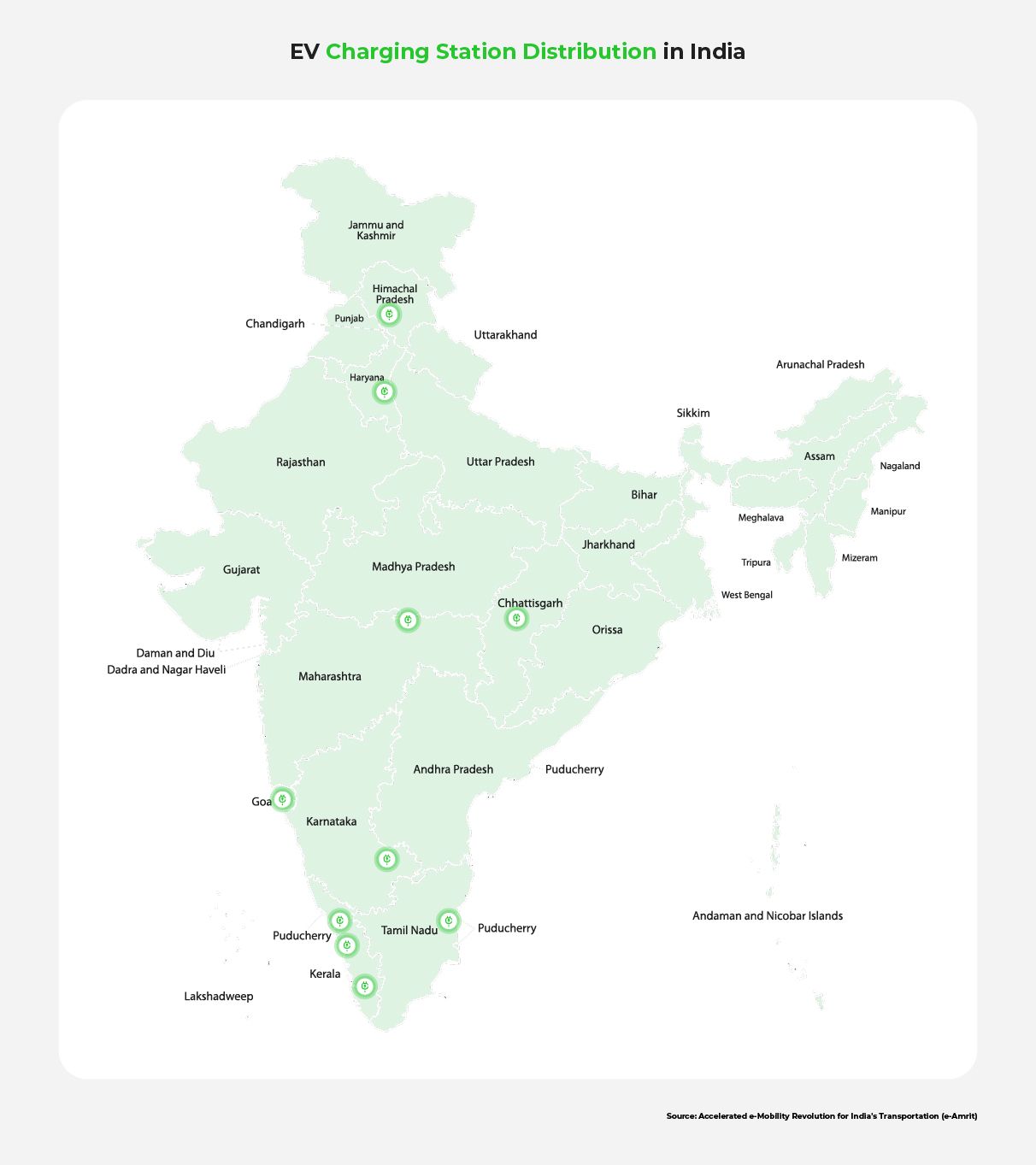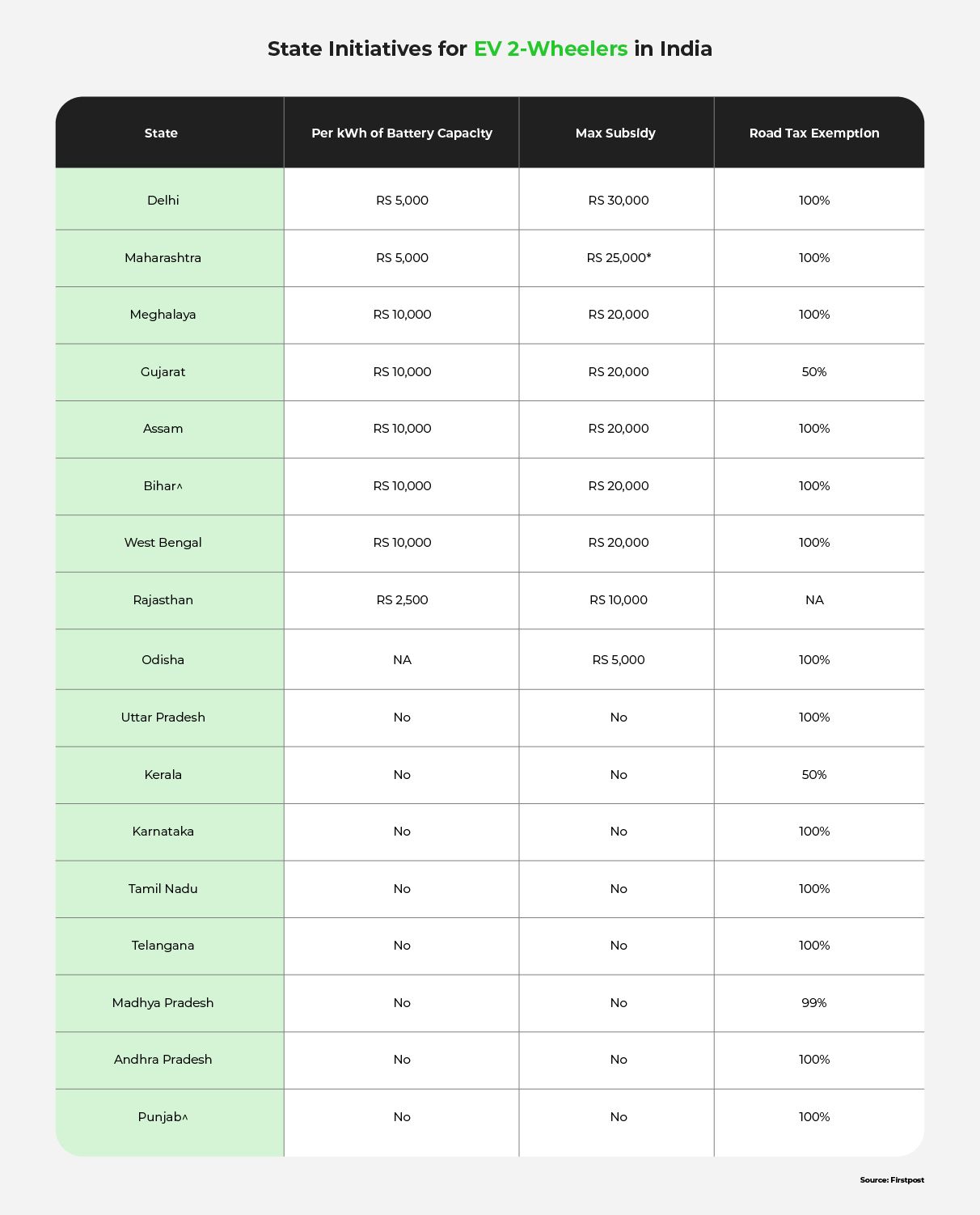The Impact Of EV Charging Infrastructure On Mobility in India
Raghav Bharadwaj
Chief Executive Officer
Published on:
03 Jul, 2023
Updated on:
14 Nov, 2025

In the rapidly changing automotive world, India’s robust EV infrastructure can shape the future of mobility. However, this transformative journey faces hurdles due to inadequate charging stations, curbing the growth of electric vehicles.
The journey towards electrification, and its associated mobility shift, hinges on the implementation of a cohesive EV charging network through innovative renewable energy solutions and advanced battery technology. Effecting this shift is crucial for socioeconomic development, environmental preservation, and sustainable transportation.
This article investigates these challenges and the potential of stakeholder collaboration to expedite the deployment of EV infrastructure by addressing the following questions:
- What challenges does India’s transportation sector face, and why is India struggling to address them?
- How can EVs and EV charging infrastructure help address the transportation sector’s challenges and improve Indians’ mobility?
- Why is it essential for stakeholders to collaborate and overcome obstacles to fully leverage the mobility benefits of EVs and successfully deploy EV charging infrastructure?
India’s Current State of Mobility
India’s mobility landscape has grown substantially, with National Highways expanding from 97,830 km to 145,155 km in just a decade, as seen in the chart below.

Despite this progress, the transportation sector still experiences significant challenges. Critics frequently characterize India’s transportation system as insufficient and outdated. Traffic congestion, narrow roads, and inefficient public transport, cost India an estimated $22 billion a year in wasted fuel and lost productivity.
India’s slow post-pandemic economic recovery has compounded the problem. Inflation and higher borrowing rates have disrupted the automotive industry, and structural shifts related to the advent of electric mobility have created uncertainty for manufacturers and investors.
Furthermore, India’s environmental goals have made the transportation sector’s condition even more urgent. According to IQAir’s 2022 report, India contains 10 of the world’s most polluted cities.
This high pollution rate is partially due to the transportation sector, which contributes 18% to national energy consumption — equivalent to approximately 94 million tonnes of oil (MTOE). In addition, vehicular emissions like PM2.5, nitrogen oxides (NOx), and volatile organic compounds (VOCs) significantly affect air quality and public health.
In response to the Paris Agreement, India aims to achieve 30% EV adoption and reduce GDP emissions intensity by 33-35% by 2030. By the same year, it targets 450GW of renewable energy installations, significantly greater than its current installed capacity (82.6GW) and its 2019 electricity grid size (362GW).
This ambition necessitates a comprehensive roadmap, in which the transportation sector will play a crucial role. As a result, the Indian government is actively promoting EVs through a variety of initiatives as seen in the table below.

Obstacles to Implementing EV Charging Infrastructure To Transform Mobility In India
Expanding India’s EV market requires a robust, sustainable charging infrastructure. According to data from Customized Energy Solutions, 17,520 EV chargers were sold in 2021, with a combined capacity of 201.5 MW. These chargers were provided by EV original equipment manufacturers and procured by PSUs, commercial fleet operators, bus operators, and charging service providers.
Despite this auspicious growth, various hidden challenges still hinder the transformation of mobility, ranging from insufficient charging stations to a lack of stakeholder coordination. The high cost of establishing charging stations and a broader electricity grid poses even more problems.
1. Lack of Charging Infrastructure in Remote & Rural Areas
India’s Ministry of Power mandates a charging station every 25 km on highways, for a total of 11,596 stations. As the map below demonstrates, however, the current situation is very different.
Not only does India have a mere 1,742 stations, but most of them are situated in urban areas like Delhi, Mumbai, and Bengaluru, making for a dramatically unequal distribution of this vital EV infrastructure. The focus on urban development is understandable, given that the potential for EV usage is higher in cities, but it leaves rural areas drastically underserved.

2. Limited Grid Capacity
A 2019 Brookings India report suggests that EVs can substantially reduce the strain on India’s power grid. Even if India were to achieve 100% EV sales by 2030, electricity demand would only be around 100 terawatt-hours (TWh). Given projections, EVs would account for 1.3% to 4.8% of overall electricity demand, mitigating concerns about power capacity gaps.

However, two issues still require attention. First, EVs add to the volatility of instantaneous demand due to their high charging capacities, potentially affecting grid stability.
Second, although actual charging hours might be low, the surge in power requirement when EVs are plugged in would be high, meaning that increased EV adoption might create unforeseen problems by transforming the demand pattern of electricity in India.
Adopting smart grid strategies is, therefore, essential to managing peak demand and ensuring reliable power supply to charging stations.
3. Technological Limitations
All three of the currently available EV charging technologies — conductive charging, inductive charging, and battery swapping — come with their own challenges and limitations.
- Conductive charging, using either AC or DC, hinges on an onboard charger. While DC can charge 80% of an EV battery within 30 minutes, it costs more and can accelerate battery degradation with frequent use. AC charging is more economical but requires 4 to 10 hours for a full charge using 240V.
- Inductive charging involves wireless electricity transmission through induction, reducing land needs but increasing costs due to auxiliary devices like high-frequency transformers and SCADA systems.
- Battery swapping stations present a unique solution, substituting drained batteries with fully charged ones. However, standardizing batteries, addressing ownership issues, and concerns over degradation pose their own problems.
As a result, research in charging technology is critical. Technological breakthroughs will overcome the current limitations, enable mass production of charging equipment, and facilitate large-scale infrastructure, thereby alleviating ‘range anxiety’ for prospective EV owners.
4. Regulatory and Policy Barriers
India’s Faster Adoption and Manufacturing of Hybrid and Electric Vehicles (FAME) schemes are aimed at promoting EV adoption. However, compared to other countries with similar schemes — such as Singapore’s, whose comprehensive approach uses tax incentives, regulations, and standards to support EVs — India still has miles to go.
Singapore’s goal of deploying 60,000 EV charging points by 2030 sets a significant benchmark. If India is to catch up, it will have to address challenges like inadequate charging infrastructure, high EV costs, lack of consumer awareness about EV technology, and the need for better coordination among governmental bodies and the public-private sectors.
Why Is India Struggling to Address These Challenges?
Transforming mobility in India, a diverse, sprawling nation, via the adoption of EVs presents significant challenges, particularly given India’s large automobile market. To scale the necessary infrastructure, India needs a vast number of charging stations. This requires considerable investments of time, funds, and logistical efforts. Stable energy supply and grid reliability are also crucial for the deployment of EV infrastructure. However, India still faces grid stability issues, especially in rural regions.
The cost of developing EV charging infrastructure is a potential deterrent to investors, as the Indian market values cost-effectiveness. The complexity of policy and regulatory issues exacerbates these economic challenges. Because India’s EV policy framework is still evolving, many crucial areas, such as charging infrastructure standards, charger grid integration, and power tariffs, remain unclear.
Furthermore, public awareness and acceptance of EVs remain relatively low in India, slowing demand and, consequently, infrastructure development. The urban-rural disparity in infrastructure development also needs to be addressed for a successful nationwide transition to EVs. Most developments are concentrated in urban areas, leaving rural regions underserved.
Finally, current battery technology and charging speeds pose a concern. Charging an EV is significantly more time-consuming than refueling a conventional vehicle, which might discourage potential EV adopters.
Overcoming these barriers demands concerted efforts from the government, private sector, and consumers. These could involve financial incentives to offset infrastructure costs, grid enhancements, streamlined policy and regulatory frameworks, and public education campaigns on EV benefits, all of which are critical to India’s sustainable transportation shift.
Solutions for Successful EV Charging Infrastructure Deployment
Key strategies for bolstering India’s EV charging infrastructure include standardization of charging protocols for interoperability and user experience, innovative charging solutions, and multi-stakeholder collaboration, all of which will enhance EV convenience and efficiency.
1. Development of Charging Infrastructure in Remote & Rural Areas
Expanding charging infrastructure to rural areas is crucial for nationwide EV adoption in India. Innovative solutions, like solar-powered stations and mobile units, can address limited grid connectivity.
Solar-powered stations utilize renewable energy to provide sustainable charging options, while mobile units can bring charging facilities directly to remote locations, ensuring on-the-go charging options for remote EV users.
2. Partnership and Collaboration to Improve Infrastructure and Mobility
Establishing a comprehensive EV charging network in India requires the synergistic collaboration of multiple stakeholders, including government entities, private firms, and communities.
Harnessing public-private partnerships can marshal requisite investments and expertise, facilitating infrastructure development. Expanding existing alliances among auto manufacturers, charging station providers, and regulatory bodies will provide the impetus for wider, transformative impacts.
3. Technology and Standards
Standardization of charging systems for interoperability among various EV models is a crucial step toward addressing “charging point anxiety”. Incorporating technological advancements such as fast charging, wireless charging, and vehicle-to-grid technology can also significantly elevate the EV charging infrastructure’s usability and accessibility.
4. Smart Grid and Energy Storage
Implementing smart grid technology and energy storage solutions can help manage peak power demand and ensure a reliable power supply for EV charging stations. These technologies can balance electricity loads, store excess power during off-peak times for use during high-demand periods, and enhance the overall efficiency and reliability of the power grid.
5. Supportive Policies and Regulations
Policies and regulations that incentivize EV adoption and facilitate the deployment of charging infrastructure are essential catalysts for a thriving EV ecosystem. For instance, tax incentives, low-interest loans for charging station installation, and mandatory EV charging provisions in building codes can boost the growth of EVs and charging infrastructure. Governmental initiatives to subsidize EV purchases or provide free or discounted charging can further accelerate the adoption of EVs.
Fortunately, many states have already adopted initiatives for charging infrastructure planning. The table below shows some states’ incentives for EV 2-wheelers specifically. However, the same can apply to all types of EVs to fully transform mobility in India.

Improving Indian Mobility via EV Charging Infrastructure
As urban migration strains India’s mobility infrastructures, the government looks to EVs for sustainable solutions. Rapidly increasing vehicle ownership, especially two-wheelers, raises energy consumption to unsustainable levels. It also perpetuates India’s oil dependency; transport accounted for a full 50% of India’s oil use in 2020.
Transitioning to EVs could mitigate pollution, reduce oil dependency, and stimulate economic opportunities. Therefore, India needs to pursue cleaner energy and greener low-carbon fuel, with electric mobility and clean energy vehicles taking the lead.
Achieving these benefits requires widespread societal backing for pro-EV policies and substantial expansion of the EV charging infrastructure.
Increased Access to Transportation Options
Boosting the number of EV charging stations across India enhances the convenience of charging EVs, mitigating range anxiety and thereby promoting wider adoption of these vehicles.
A comprehensive charging infrastructure not only incentivizes EV usage but also catalyzes the growth of the e-mobility sector, generating considerable progress toward a sustainable and environmentally friendly transportation ecosystem.
Improved Range and Reliability for EVs
Technological advancements are improving EV range capabilities, thereby rendering EVs more suitable for long-distance travel. A reliable and accessible charging infrastructure boosts user confidence, emboldening EV owners to undertake longer journeys without the fear of running out of charge. The distribution of charging points is a key factor in alleviating range anxiety and encouraging acceptance of EVs.
Increased Innovation and Technology Development
Expanding EV charging infrastructure isn’t just a logistical necessity; it also acts as a springboard for further innovation and technological breakthroughs in the EV industry.
This sector’s evolution can yield enhancements in battery technology, charging speeds, and other related areas. In essence, fostering a robust EV charging infrastructure in India is akin to building an innovative, inclusive, and efficient mobility ecosystem.
The Future Impact of EVs on India’s Mobility
The Indian government recognizes the need for a sustainable transportation solution and is prioritizing EVs. However, challenges in developing EV charging infrastructure hinder the widespread adoption of EVs. These challenges include inadequate charging stations, limited grid capacity, technological limitations, regulatory barriers, and public awareness.
Overcoming these barriers will require collaboration between stakeholders, standardization of charging protocols, innovative charging solutions, and the expansion of infrastructure in rural areas. Smart grid strategies, supportive policies, and advancements in battery technology and charging speeds are also essential.
By addressing these challenges and developing a comprehensive EV charging network, India can build a brighter future by transforming its mobility landscape, reducing pollution, and fostering economic growth.

FAQs
How does EV charging infrastructure affect mobility in India?
EV charging infrastructure is pivotal to India’s mobility transformation; having adequate charging stations encourages EV adoption by alleviating range anxiety. At the moment, however, infrastructure is concentrated in urban areas, leaving rural regions underserved and thereby hindering widespread EV adoption.
How will installing more public charging stations benefit EV owners in India?
Installing public charging stations makes charging EVs more convenient. This boosts EV owners’ confidence for long journeys, thereby promoting wider adoption and growth of the e-mobility sector in India. It will also benefit the business landscape for fleet operators.
What incentives are available for the installation of private charging stations in India?
Incentives for private charging stations in India could include tax benefits, low-interest loans for charging station installation, and mandatory EV charging provisions in building codes to stimulate infrastructure growth.
How can EV-friendly policies like tax credits and toll exemptions incentivize the adoption of EVs in India?
EV-friendly policies like tax credits and toll exemptions reduce the overall cost of EV ownership, thereby making them a more attractive and affordable option for potential EV owners in India.
What role can private companies play in developing and operating EV charging infrastructure in India?
Private companies can enter into public-private partnerships to provide the necessary investment, expertise, and innovative solutions for the development and operation of a comprehensive EV charging network, facilitating transformative impacts in the EV industry.
How can the availability of EV charging infrastructure impact the growth of the EV market in India?
Creating a widely available EV charging infrastructure can stimulate the growth of the EV market in India by alleviating range anxiety, enhancing the usability of EVs, and providing a springboard for further technological innovation in the transportation sector.

Jan 07, 2026 • EV Events and Industry Reports
Maharashtra’s New Electric Vehicle Policy (2025–2030)
Read More



